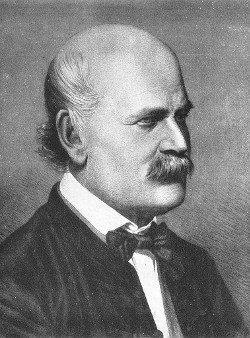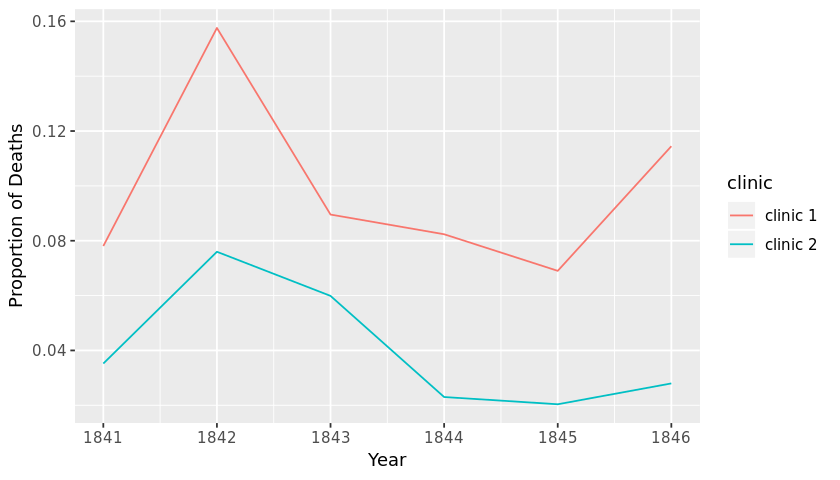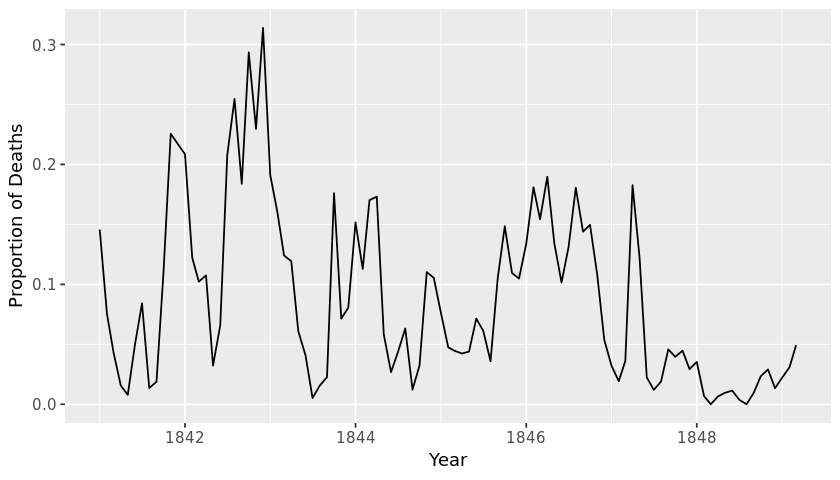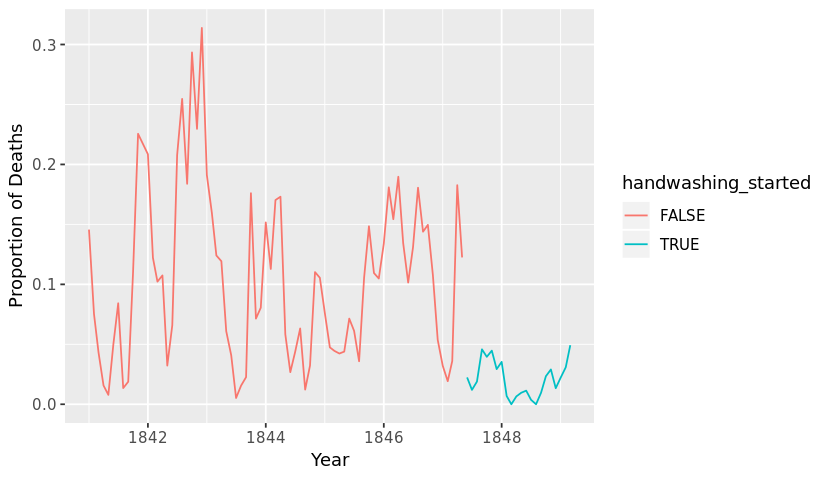Statistics Project: Handwashing

Meet Dr. Ignaz Semmelweis
Dr. Ignaz Semmelweis, a Hungarian physician born in 1818, who was active at the Vienna General Hospital and thinking about childbed fever: A deadly disease affecting women that just have given birth in the early 1840s. At the Vienna General Hospital, as many as 10% of the women giving birth died from it. He is thinking about it because he knows the cause of childbed fever: It’s the contaminated hands of the doctors delivering the babies. And they won’t listen to him and wash their hands!
In this analysis, we’re going to reanalyze the data that made Semmelweis discover the importance of handwashing. Let’s start by looking at the data that made Semmelweis realize that something was wrong with the procedures at Vienna General Hospital.
R code block:
# Load in the tidyverse package
library(tidyverse)
# Read datasets/yearly_deaths_by_clinic.csv into yearly
yearly <- read_csv("datasets/yearly_deaths_by_clinic.csv")
The data shows the number of women giving birth at the two clinics at the Vienna General Hospital for the years 1841 to 1846. You’ll notice that giving birth was very dangerous; an alarming number of women died as the result of childbirth, most of them from childbed fever.
We see this more clearly if we look at the proportion of deaths out of the number of women giving birth.
R code block:
# Adding a new column to yearly with proportion of deaths per no. births
yearly <- yearly %>% mutate(proportion_deaths = deaths/births)
If we now plot the proportion of deaths at both clinic 1 and clinic 2 we’ll see a curious pattern…
R code block:
# Setting the size of plots in this notebook
options(repr.plot.width = 7, repr.plot.height = 4)
# Plot yearly proportion of deaths at the two clinics
ggplot(yearly, aes(x = year, y = proportion_deaths, color = clinic)) +
geom_line() +
labs(x = "Year", y = "Proportion of Deaths")

The handwashing begins
Why is the proportion of deaths constantly so much higher in Clinic 1? Semmelweis saw the same pattern and was puzzled and distressed. The only difference between the clinics was that many medical students served at Clinic 1, while mostly midwife students served at Clinic 2. While the midwives only tended to the women giving birth, the medical students also spent time in the autopsy rooms examining corpses.
Semmelweis started to suspect that something on the corpses, spread from the hands of the medical students, caused childbed fever. So in a desperate attempt to stop the high mortality rates, he decreed: Wash your hands! This was an unorthodox and controversial request, nobody in Vienna knew about bacteria at this point in time.
Let’s load in monthly data from Clinic 1 to see if the handwashing had any effect.
R code block:
# Read datasets/monthly_deaths.csv into monthly
monthly <- read_csv("datasets/monthly_deaths.csv")
# Adding a new column with proportion of deaths per no. births
monthly <- monthly %>% mutate(proportion_deaths = deaths/births)
With the data loaded we can now look at the proportion of deaths over time. In the plot below we haven’t marked where obligatory handwashing started, but it reduced the proportion of deaths to such a degree that you should be able to spot it!
R code block:
# Plot monthly proportion of deaths
ggplot(monthly, aes(x = date, y = proportion_deaths)) +
geom_line() +
labs(x = "Year", y = "Proportion of Deaths")

Starting from the summer of 1847 the proportion of deaths is drastically reduced and, yes, this was when Semmelweis made handwashing obligatory.
The effect of handwashing is made even more clear if we highlight this in the graph.
R code block:
# From this date handwashing was made mandatory
handwashing_start = as.Date('1847-06-01')
# Add a TRUE/FALSE column to monthly called handwashing_started
monthly <- monthly %>%
mutate(handwashing_started =
date >= handwashing_start)
# Plot monthly proportion of deaths before and after handwashing
ggplot(monthly, aes(x = date, y = proportion_deaths, color = handwashing_started)) +
geom_line() +
labs(x = "Year", y = "Proportion of Deaths")

More handwashing, fewer deaths? A statistical analysis of Semmelweis handwashing data
Again, the graph shows that handwashing had a huge effect. How much did it reduce the monthly proportion of deaths on average?
R code block:
# Calculating the mean proportion of deaths
# before and after handwashing.
monthly_summary <- monthly %>%
group_by(handwashing_started) %>%
summarize(mean_proportion_deaths = mean(proportion_deaths))
It reduced the proportion of deaths by around 8 percentage points! From 10% on average before handwashing to just 2% when handwashing was enforced (which is still a high number by modern standards). To get a feeling for the uncertainty around how much handwashing reduces mortalities we could look at a confidence interval (here calculated using a t-test).
R code block:
# Calculating a 95% Confidence intrerval using t.test
test_result <- t.test(proportion_deaths ~ handwashing_started, data = monthly)
test_result
Welch Two Sample t-test:
- t = 9.61
- df = 92
- p-value = 1
95 percent confidence interval: (0.067, 0.101)
The fate of Dr. Semmelweis
That the doctors didn’t wash their hands increased the proportion of deaths by between 6.7 and 10 percentage points, according to a 95% confidence interval. All in all, it would seem that Semmelweis had solid evidence that handwashing was a simple but highly effective procedure that could save many lives.
The tragedy is that, despite the evidence, Semmelweis’ theory — that childbed fever was caused by some “substance” (what we today know as bacteria) from autopsy room corpses — was ridiculed by contemporary scientists. The medical community largely rejected his discovery and in 1849 he was forced to leave the Vienna General Hospital for good.
One reason for this was that statistics and statistical arguments were uncommon in medical science in the 1800s. Semmelweis only published his data as long tables of raw data, but he didn’t show any graphs nor confidence intervals. If he would have had access to the analysis we’ve just put together he might have been more successful in getting the Viennese doctors to wash their hands.
R code block:
# The data Semmelweis collected points to that:
doctors_should_wash_their_hands <- TRUE
